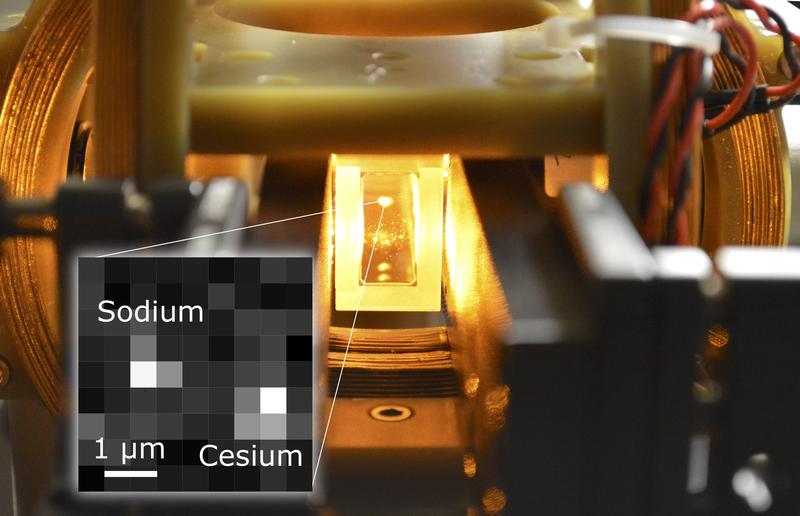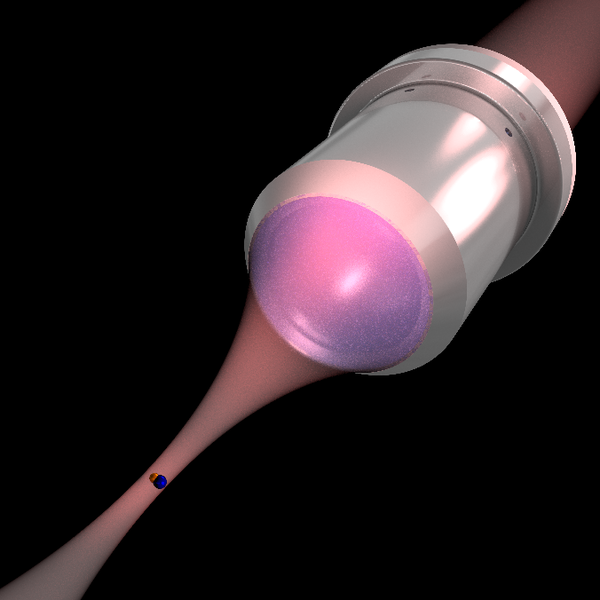
A revolutionary process could help realize the first quantum computer
By Caitlin McDermott-Murphy
How do you make green? Simple. Mix yellow and blue.
How do you make the molecule NaCs? Join a sodium atom (Na) and a cesium atom (Cs). The instructions seem simple. But molecules, the foundation of everything around us, are not so easy to manipulate.
Individual atoms, minuscule and volatile, bounce apart unless they lose some of their kinetic energy. So, to induce chemical reactions, researchers cross two molecular beams—teeming with gaseous molecules—in a vacuum chamber. Like two crowds hustling in opposite directions, some of the molecules might just collide, pair up, and rush off with different speed and direction.
In 1986, Dudley Herschbach, Yuan T. Lee and John C. Polanyi won a Nobel Prize in Chemistry for these experiments, which provided researchers with essential tools to study reaction dynamics.
Now, Kang-Kuen Ni, Assistant Professor of Chemistry and Chemical Biology, has helped expand this field. She contributed to the very first experiments in ultracold chemistry, where molecules are cooled to temperatures so low they enter an isolated, quantum state. This method provides a more controlled way to observe reactions, which are, according to Ni, “surprisingly efficient at a temperature that is less than a thousandth of a degree above absolute zero.”
In a recently-published paper in Science, Ni uses ultracold chemistry to achieve a world first: the creation of one molecule from exactly two atoms.

|
A laser-cooled cloud of a million sodium atoms suspended inside a glass cell vacuum apparatus.Inset: microscope view of fluorescence from individual sodium and cesium atoms trapped side-by-side [Credit: Lee Liu and Yu Liu]. |
To build her molecule, Ni captures each atom in its own “optical tweezer,” a highly focused laser beam, and then merges the two tweezers to trap the atoms in one. Once in place, Ni introduces light as an energy source to excite the atoms to react and bond.
“It’s true that for every reaction,” Ni said, “atoms and molecules combine individually at the microscopic level. What we have done differently is to create more control over it. We grab two different species of individual atoms with optical tweezers and shine a pulse of laser to bind them. The whole process is happening in an ultra-high vacuum, with very low air density.”
|
|
"Ni's experiment is awesome. [It's like] bringing together two lonely people, walking very slowly, shaking hands."- Dudley Herschbach, Frank B. Baird, Jr. Professor of Science and Nobel Prize Laureate |
Herschbach likens her “remarkable experiment” to “bringing together two lonely people, walking very slowly, shaking hands.” And, he adds, “Ni’s experiment is awesome.”
Ni’s work could lead to new, fundamental understanding of how chemical reactions occur. In particular, it allows researchers to observe them at extremely low temperatures, where the atoms behave as quantum waves. Such foundational insights into quantum dynamics will likely enhance the field of chemistry and beyond.
In particular, Ni’s work promises to advance quantum computing. Since ultracold two-atom (dipolar) molecules can carry masses of quantum information and retain it for long periods, they make enticing candidates as qubits, the building blocks of quantum computers.
“The direction of quantum information processing is one of the things we’re excited about,” Ni said. “We need molecules for all different applications in our daily lives. However, the molecular space is so huge, we cannot sufficiently explore it with current computers. If we have quantum computers that could potentially solve complex problems and explore molecular space efficiently, the impact will be large.”
Moving forward, Ni hopes to build larger, more complex molecules with her innovative method. And, in time, her designer qubits could provide a powerful new architecture for quantum computers.
Graphic: A single molecule is produced in an optical tweezer by a controlled reaction between a single sodium and single cesium atom [Credit: Andrei Gheorghe and Lee Liu; Objective CAD: JENOPTIK Optical Systems LLC]

